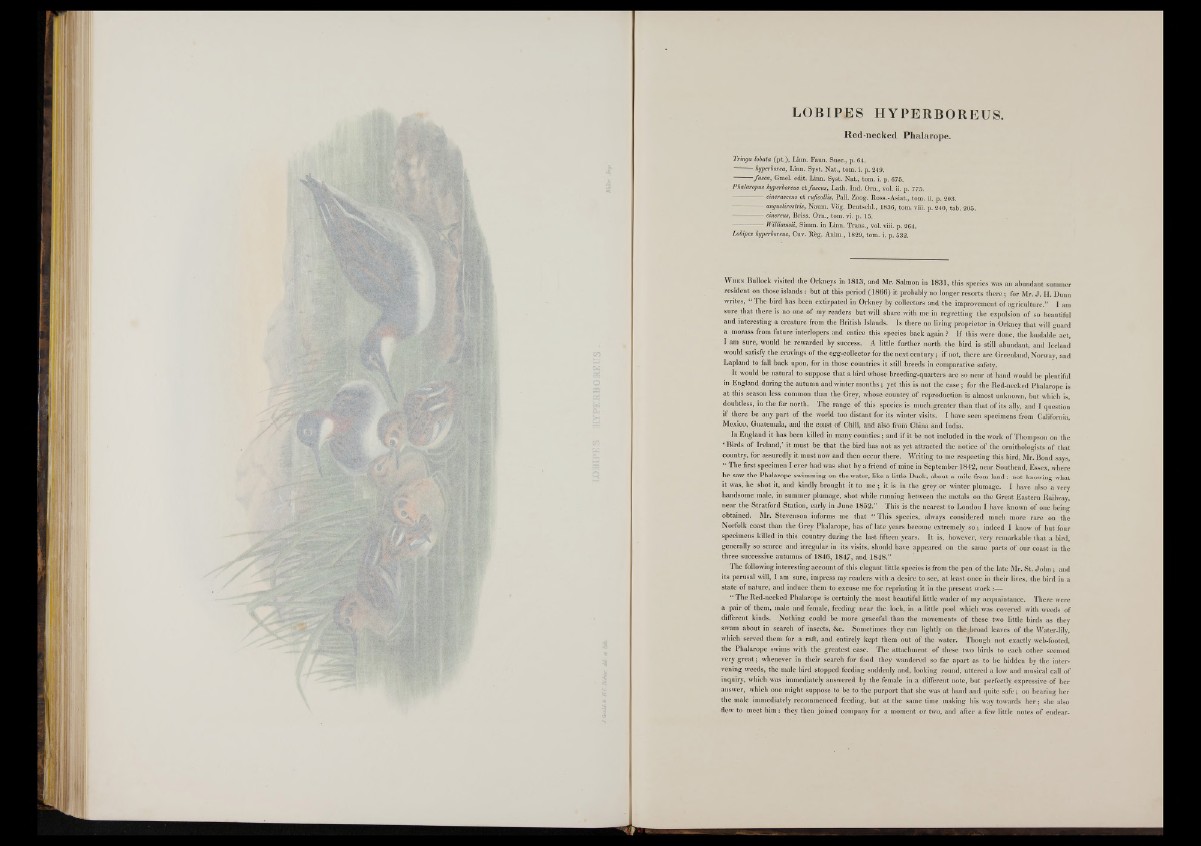
LOBIPES HYPERBOREUS.
Red-necked Phalarope.
Tringa lobata (pt.), Linn. Faun. Suec., p. 64.
hyperborea, Linn. Syst. Nat., tom. i. p. 249.
fusca, Gmel. edit. Linn. Syst. Nat., tom. i. p. 675.
Phalaropus hyperboreus et fuscus, Lath. Ind. Om., vol. ii. p. 775.
— cinerascens et ruficollis, Pall. Zoog. Ross.-Asiat., tom. ii. p. 203.
— angustirostris, Naum. Vog. Deutschl., 1836, tom. viii. p. 240, tab. 205.
— ■— cinereus, Briss. Om., tom. vi. p. 15.
— Williamsii, Simm. in Linn. Trans., vol. viii. p.. 264.
Lobipes hyperboreus, Cuv. Rfeg. Anim., 1829, tom. i. p. 532.
W h e n Bullock visited the Orkneys in 1813, and Mr. Salmon in 1831, this species was an abundant summer
resident on those islands: but a t this period (1866) it probably no longer resorts th e re ; for Mr. J . H. Dunn
writes, “ The bird has been extirpated in Orkney by collectors and the improvement o f agriculture.” I am
sure that there is no one o f my readers but will share with me in regretting the expulsion o f so beautiful
and interesting a creature from the British Islands. Is there no living proprietor in Orkney that will guard
a morass from future interlopers and entice this species back again ? If this were done, the laudable act,
I am sure, would be rewarded by success. A little further north the bird is still abundant, and Iceland
would satisfy the cravings o f the egg-collector for the next century; if not, there are Greenland, Norway, and
Lapland to fall back upon, for in those countries it still breeds in comparative safety.
I t would be natural to suppose that a bird whose breeding-quarters are so near a t hand would be plentiful
in England during the autumn and winter m onths; yet this is not the case; for the Red-necked Phalarope is
a t this season less common than the Grey, whose country o f reproduction is almost unknown, but which is,
doubtless, in the far north. The range o f this species is much.greater than that of its ally, and I question
if there be any p art of the world too distant for its winter visits. I have seen specimens from California,
Mexico, Guatemala, and the coast o f Chili, and also from China and India.
In England it has been killed in many counties; and if it be not included in the work o f Thompson on the
‘ B irds of Ireland,’ it must be that the bird has not as yet attracted the notice o f the ornithologists o f that
country, for assuredly it m ust now and then occur there. Writing to me respecting this bird, Mr. Bond says,
“ The first specimen I ever had was shot by a friend of mine in September 1842, near Southend, Essex, where
he saw the Phalarope swimming on the water, like a little Duck, about a mile from lan d : not knowing what
it was, he shot it, and kindly brought it to me ; it is in the grey or winter plumage. I have also a very
handsome male, in summer plumage, shot while running between the metals on the Great Eastern Railway,
near the Stratford Station, early in Ju n e 1852.” This is the nearest to London I have known o f one being
obtained. Mr. Stevenson informs me that “ This species, always considered much more rare on the
Norfolk coast than the Grey Phalarope, has o f late years become extremely s o ; indeed I know of but four
specimens killed in this country during the last fifteen years. I t is, however, very remarkable that a bird,
generally so scarce and irregular in its visits, should have appeared on the same parts o f our coast in the
three successive autumns of 1846, 1847, and 1848.”
The following interesting account o f this elegant little species is from the pen o f the late Mr. St. J o h n ; and
its perusal will, I am sure, impress my readers with a desire to see, at least once in their lives, the bird in a
state o f nature, and induce them to excuse me for reprinting it in the present work :—
“ The Red-necked Phalarope is certainly the most beautiful little wader of my acquaintance. There were
a pair of them, male and female, feeding near the loch, in a little pool which was covered with weeds of
different kinds. Nothing could be more graceful than the movements o f these two little birds as they
swam about in search of insects, &c. Sometimes they ran lightly on the .¡broad leaves o f the Water-lily,
which served them for a raft, and entirely kept them out o f the water. Though not exactly web-footed,
the Phalarope swims with the greatest ease. The attachment o f these two birds to each other seemed
very g r e a t; whenever in their search for food they wandered so far apart as to be hidden by the intervening
weeds, the male bird stopped feeding suddenly and, looking round, uttered a low and musical call of
inquiry, which was immediately answered by the female in a different note, but perfectly expressive o f her
answer, which one might suppose to be to the purport that she was at hand and quite safe; on hearing her
the male immediately recommenced feeding, but at the same time making his way towards h e r ; she also
flew to meet him : they then joined company for a moment or two, and after a few little notes o f endear